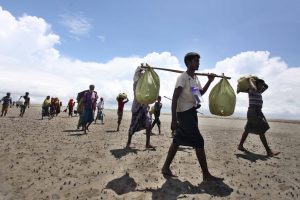Concerns are growing for a group of at least 160 Rohingya civilians who are stuck aboard a crippled vessel in the Andaman Sea, around a month after setting off from Bangladesh in an attempt to seek sanctuary in Malaysia.
In a statement yesterday, the region advocacy group ASEAN Parliamentarians for Human Rights (APHR) urged regional governments immediately to launch a search and rescue operation for the boat, after weeks of inaction.
“It is disgraceful that a boat filled with men, women, and children in grave danger has been allowed to remain adrift,” Eva Sundari, an APHR board member, said in the statement. “Neglecting the people on the boat is nothing short of an affront to humanity.”
The desperate conditions onboard the vessel, which has now reportedly drifted into Indian waters off the Andaman and Nicobar Islands, have been captured in a recorded satellite phone call between the ship’s captain and Mohamed Khan Rezuwan, a Rohingya activist living in one of the several large refugee camps in Bangladesh’s Cox’s Bazar.
In the nearly two minute recording on December 18, which Rohingya advocates posted on social media and sent to media organizations including The Diplomat, the captain of the vessel can be heard providing the satellite coordinates of the ship. “We are dying here,” the captain says in the recorded call. “We haven’t eaten anything for eight to ten days. We are starving. Three people have died.”
The vessel reportedly set off in late November from the coast of Bangladesh, home to around 1 million Rohingya refugees who have fled persecution and violent attacks in western Myanmar’s Rakhine State. Its intended destination was Malaysia, where more than 105,000 Rohingya refugees are registered with the United Nations refugee agency UNHCR, and which, despite a recent immigration crackdown, is seen as relatively friendly toward Rohingya asylum seekers.
On December 1, however, the vessel’s engines failed and it has been adrift ever since. UNHCR has since issued two appeals for the rescue of the “non-seaworthy vessel” and its occupants, on December 8 and December 16. In the latter statement, it said that there was “a significant risk of additional fatalities in the coming days if people are not rescued and disembarked to safety.” It added, “We appeal to all authorities in the region to fully deploy their rescue capacities and promptly facilitate disembarkation for this group to a place of safety. The priority must now be to save lives and avoid even greater tragedy.”
Rohingya refugees and asylum seekers have been seeking sanctuary by sea for years, seeking to escape both severe persecution in Myanmar and the precarity of life in the Bangladeshi refugee camps. Very often this involves putting their lives in the hands of human smugglers who send them on journeys through the Andaman Sea on leaky and dangerously ill-equipped vessels.
With the Rohingya refugee crisis showing little sign of a resolution, especially in light of the chaos that has followed the February 2021 military coup in Myanmar, the number of boats setting off has risen significantly. UNHCR recently warned of the “dramatic increase” in the number of people attempting perilous crossings of the Andaman Sea in 2022. Some 1,920 people, mostly Rohingya, traveled by sea between January and November, from Myanmar and Bangladesh, compared to only 287 in the whole 2021. It stated that 119 people “have been reported dead or missing on these journeys” this year.
In December alone, two other vessels have been reported stranded. One carrying 154 refugees was rescued by a Vietnamese oil service vessel on December 8 and handed over to the Myanmar navy. Another was rescued by the Sri Lankan navy on December 18, with 104 refugees aboard.

































